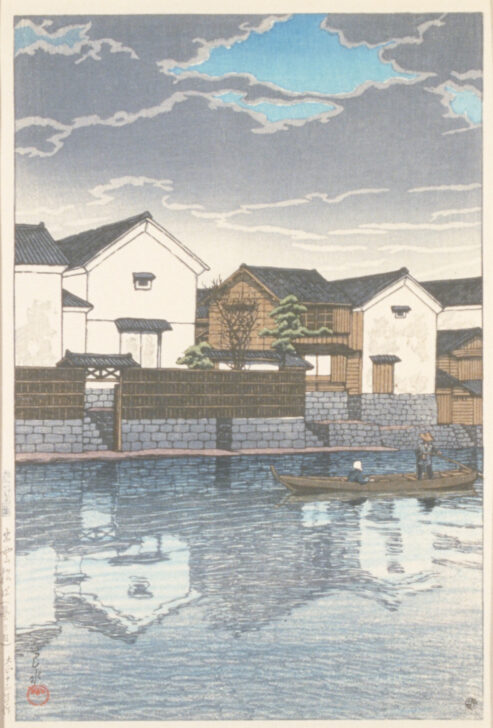From “Souvenirs of Travels,” third series
Kawase Hasui

Description
Cloudy Day (Japanese, Kumoribi) is one of three different prints of this same scene by Kawase Hasui made from the same set of woodblocks. The difference lies in the colors used and the sky block. UMMA owns another print from this series, "Crescent Moon," 1987/1.268.
M. Graybill, Senior Curator of Asian Art, 3/07
---
Kawase Hasui and Takahashi Hiroaki both worked in concert with the prolific twentieth century publisher of woodblock prints Watanabe Shôzaburô (1885-1962). Their poetic and often times nostalgic landscape prints, very much following Edo period print master Andô Hiroshige’s foot prints (whose works are also shown in the gallery), have been highly sought after by collectors in Europe and North America.
Kawase Hasui was especially known for his skillful depiction of landscapes and night scenes. His passion for landscapes led him to travel extensively throughout Japan, keeping a sensitive eye on his surroundings and sketching scenes from his journeys. His close attention to atmospheric conditions and light brought him much success and one year before his death Kawase was awarded the great honor of Living Cultural Treasure for his 1956 print “Snow at Zôjôji Temple.”
Takahashi was trained in Japanese style painting (Nihonga), and dedicated much of his time to creating paintings for exhibitions as well as illustrations for scientific publications. While Kawase’s prints focus on notable places and landscapes, Takahashi’s work attempts to capture the essence of Japanese culture and everyday life.
(Japanese Gallery Rotation, Spring 2010)
*Gallery Rotation Winter 2011 (January 2011)
(6/28/10)
Kawase Hasui
Japan, 1883–1957
Matsue, Izumo (Cloudy Day)
1924
Taisho Period (1912–26)
Color woodblock print on paper
Museum purchase made possible by the Friends of the Museum of Art, 1987/1.267
Subject Matter:
Kawase Hasui worked in concert with the prolific twentieth century publisher of woodblock prints Watanabe Shôzaburo (1885-1962).
Kawase Hasui was especially known for his skillful depiction of landscapes and night scenes. His passion for landscapes led him to travel extensively throughout Japan, keeping a sensitive eye on his surroundings and sketching scenes from his journeys. His close attention to atmospheric conditions and light brought him much success and one year before his death Kawase was awarded the great honor of Intangible Cultural Treasure for his 1956 print “Snow at Zôjôji Temple.”
Physical Description:
A man stewards a narrow boat carrying a passenger along a river. The houses and walls alongside reflect on the river's surface. The sky is nearly covered by gray clouds, but small patches of blue sky shine through.
Usage Rights:
If you are interested in using an image for a publication, please visit https://umma.umich.edu/request-image/ for more information and to fill out the online Image Rights and Reproductions Request Form.